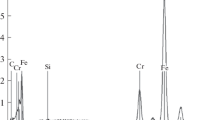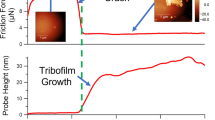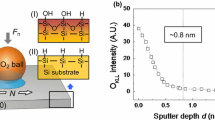Abstract
Diamond and diamond-like carbon are used as coating materials for numerous applications, ranging from biomedicine to tribology. Recently, it has been shown that the hydrophilicity of the carbon films can be enhanced by silicon doping, which highly improves their biocompatibility and frictional performances. Despite the relevance of these properties for applications, a microscopic understanding on the effects of silicon is still lacking. Here, we apply ab initio calculations to study the interaction of water molecules with Si-incorporating C(001) surfaces. We find that the presence of Si dopants considerably increases the energy gain for water chemisorption and decreases the energy barrier for water dissociation by more than 50 %. We provide a physical rational for the phenomenon by analyzing the electronic charge displacements occurring upon adsorption. We also show that once hydroxylated, the surface is able to bind further water molecules much strongly than the clean surface via hydrogen bond networks. This two-step process is consistent with and can explain the enhanced hydrophilic character observed in carbon-based films doped by silicon.







Similar content being viewed by others
Notes
The latter are identified by comparing the water adsorption energy at different locations. In particular, we sample six positions on a homogeneous grid along the [110] direction centered on the Si atom and covering the heterodimer and half of the sp 3 trench. The in-plane coordinates of the oxygen atom are fixed at the grid point, and all the other degrees of freedom are fully relaxed except for the slab bottom layer
References
Sanchez-Lopez, J.C., Fernandez, A.: Doping and alloying effects on DLC coatings. In: Donnet, C., Erdemir, A. (eds.) Tribology of diamond-like carbon films, pp. 311–338. Springer, New York (2008)
Bewilogua, K., Hofmann, D.: History of diamond-like carbon films—from first experiments to worldwide applications. Surf. Coat. Technol. 242, 214–225 (2014)
Donnet, C.: Recent progress on the tribology of doped diamond-like and carbon alloy coatings: a review. Surf. Coat. Technol. 100–101, 180–186 (1998)
Grill, A.: Diamond-like carbon: state of the art. Diam. Relat. Mater. 8, 428–434 (1999)
Mori, H., Tachikawa, H.: Increased adhesion of diamond-like carbon–Si coatings and its tribological properties. Surf. Coat. Technol. 149, 224–229 (2002)
Miyake, S., Kaneko, R., Kikuya, Y., Sugimoto, I.: Micro-tribological studies on fluorinated carbon films. ASME J. Tribol. Trans. 113, 384–389 (1991)
Camargo Jr, S.S., Santos, R.A., Neto, A.L.B., Carius, R., Finger, F.: Structural modifcations and temperature stability of silicon incorporated diamond-like a-C: H films. Thin Solid Films 332, 130–135 (1998)
Wu, W.J., Hon, M.H.: Thermal stability of diamond-like carbon films with added silicon. Surf. Coat. Technol. 111, 134–140 (1999)
Varma, A., Palshin, V., Meletis, E.I.: Structure-property relationship of Si-DLC films. Surf. Coat. Technol. 148, 305–14 (2001)
Hatada, R., Flege, S., Baba, K., Ensinger, W., Kleebe, H.-J., Sethmann, I., Lauterbach, S.: Temperature dependent properties of silicon containing diamondlike carbon films prepared by plasma source ion implantation. J. Appl. Phys. 107, 083307 (2010)
Zhao, Q., Liu, Y., Wang, C., Wang, S.: Bacterial adhesion on silicon-doped diamond-like carbon films. Diam. Relat. Mater. 16, 1682–1687 (2007)
Bendavid, A., Martin, P.J., Comte, C., Preston, E.W., Haq, A.J., MagdonIsmail, F.S., Singh, R.K.: The mechanical and biocompatibility properties of DLC-Si films prepared by pulsed DC plasma activated chemical vapor deposition. Diam. Relat. Mater. 16, 1616–1622 (2007)
Oguri, K., Arai, T.: Friction coefficient of Si–C, Ti–C and Ge–C coatings with excess carbon formed by plasma-assisted chemical vapour deposition. Thin Solid Films 208, 158–160 (1992)
Kim, M.G., Lee, K.R., Eun, K.Y.: Tribological behavior of silicon-incorporated diamond-like carbon films. Surf. Coat. Technol. 112, 204–209 (1999)
Ikeyama, M., Nakao, S., Miyagawa, Y., Miyagawa, S.: Effects of Si content in DLC films on their friction and wear properties. Surf. Coat. Technol. 191, 38–42 (2005)
Lanigan, J., Zhao, H., Morina, A., Neville, A.: Tribochemistry of silicon and oxygen doped, hydrogenated Diamond-like Carbon in fully-formulated oil against low additive oil. Tribol. Int. 82, 431–442 (2015)
Wu, X., Ohana, T., Tanaka, A., Kubo, T., Nanao, H., Minami, I., Mori, S.: Tribochemical reaction of Si-DLC coating in water studied by stable isotopic tracer. Diam. Relat. Mater. 17, 147–153 (2008)
Takahashi, N.: Analysis of silanol by derivatization XPS. R&D Rev. Toyota CRDL 41, 52 (2006)
Mori, H., Takahashi, N., Kazuyuki, N., Tachikawa, H., Ohmori, T.: Low friction property and its mechanism of DLC-Si films under dry sliding conditions. SAE Int. 07M–426, 16 (2007)
Kato, N., Mori, H., Takahashi, N.: Spectroscopic ellipsometry of silicon-containing diamond-like carbon (DLC-Si) films. Phys. Stat. sol. 5, 1117–1120 (2008)
Washizu, H., Sand, S., Hyodo, S., Ohmori, T., Nishino, N., Suzuki, A.: Molecular dynamics simulations of elasto-hydrodynamic lubrication and boundary lubrication for automotive tribology. J. Phys.: Conf. Ser. 89, 012009 (2007)
Dearnaley, G., Arps, J.H.: Biomedical applications of diamond-like carbon (DLC) coatings: a review. Surf. Coat. Technol. 200, 2518–2524 (2005)
Saitoa, T., Hasebea, T., Yohenaa, S., Matsuokaa, Y., Kamijoc, A., Takahashic, K., Suzukia, T.: Antithrombogenicity of fluorinated diamond-like carbon films. Diam. Relat. Mater. 14, 1116–1119 (2005)
Borisenko, K.B., Reavy, H.J., Zhao, Q., Abel, E.W., Biomed, J.: Adhesion of protein residues to substituted (111) diamond surfaces: an insight from density functional theory and classical molecular dynamics simulations. Mater. Res. A 86, 1113–1121 (2008)
Yi, J.W., Moon, M.W., Ahmed, S.F., et al.: Long-lasting hydrophilicity on nanostructured Si-incorporated diamond-like carbon films. Langmuir 26, 17203–17209 (2010)
Okamoto, Y.: Initial H2O-induced oxidation of C(001)-(21): a study with hybrid density-functional theory. Phys. Rev. B 58, 6760 (1998)
Manelli, O., Corni, S., Righi, M.C.: Water adsorption on native and hydrogenated diamond (001) surfaces. J. Phys. Chem. C 114, 7045–7053 (2010)
Bouchet, M.-I.B., Zilibotti, G., Matta, C., Righi, M.C., Vandenbulcke, L., Vacher, B., Martin, J.-M.: Friction of diamond in the presence of water vapor and hydrogen gas. coupling gas-phase lubrication and first-principles studies. J. Phys. Chem. C 116, 69666972 (2012)
Zilibotti, G., Corni, S., Righi, M.C.: Load-induced confinement activates diamond lubrication by water. Phys. Rev. Lett. 111, 146101 (2013)
Grossman, J.C., Schwegler, E., Galli, G.: Quantum and classical molecular dynamics simulations of hydrophobic hydration structure around small solutes. J. Phys. Chem. B 108, 15865–15872 (2004)
Iseki, T., Mori, H., Hasegawa, H., Tachikawa, H., Nakanishi, K.: Structural analysis of Si-containing diamond-like carbon. Diam. Relat. Mater. 15, 1004–1010 (2006)
Palshin, V., Tittsworth, R.C., Fountzoulas, C.G., Meletis, E.I.: X-ray absorption spectroscopy, simulation and modeling of Si-DLC films. J. Mater. Sci. 37, 1535–1539 (2002)
Nakanishi, N., Mori, H., Tachikawa, H., Itou, K., Fujioka, M., Funaki, Y.: Investigation of DLC-Si coatings in large-scale production using DC-PACVD equipment. Surf. Coat. Technol. 200, 4277–4281 (2006)
Giannozzi, P., et al.: QUANTUM ESPRESSO: a modular and open-source software project for quantum simulations of materials. J. Phys.: Condens. Matter 21, 395502 (2009)
Perdew, J.P., Burke, K., Ernzerhof, M.: Generalized gradient approximation made simple. Phys. Rev. Lett. 77, 3865 (1996)
Vanderbilt, D.: Soft self-consistent pseudopotentials in a generalized eigenvalue formalism. Phys. Rev. B 41, 7892(R) (1990)
Monkhorst, H.J., Pack, J.D.: Special points for Brillouin-zone integrations. Phys. Rev. B 13, 5188 (1976)
Henkelman, G., Jonsson, H.: Improved tangent estimate in the nudged elastic band method for finding minimum energy paths and saddle points. J. Chem. Phys. 113, 9978–9985 (2000)
Henkelman, G., Uberuaga, B.P., Jonsson, H.: A climbing image nudged elastic band method for finding saddle points and minimum energy paths. J. Chem. Phys. 113, 9901–9904 (2000)
Löwdin, P.O.: On the non-orthogonality problem connected with the use of atomic wave functions in the theory of molecules and crystals. J. Chem. Phys. 18, 365–375 (1950)
Lide, D.R.: Handbook of chemistry and physics. CRC Press, Boca Raton (2002)
Zilibotti, G., Righi, M.C., Ferrario, M.: Ab initio study on the surface chemistry and nanotribological properties of passivated diamond surfaces. Phys. Rev. B 79, 075420 (2009)
Kajita, S., Minato, T., Kato, H.S., Kawai, M., Nakayama, T.: First-principles calculations of hydrogen diffusion on rutile TiO2(110) surfaces. J. Chem. Phys. 127, 104709 (2007)
Sprik, M.: Ab initio molecular dynamics simulation of liquids and solutions. J. Phys.: Condens. Matter 8, 9405–9409 (1996)
Johnson, E.R., DiLabio, G.A.: Structure and binding energies in van der Waals dimers: comparison between density functional theory and correlated ab initio methods. Chem. Phys. Lett. 419, 333–339 (2006)
Acknowledgments
We acknowledge the CINECA consortium for the availability of high-performance computing resources and support through the ISCRA-B TRIBOGMD project.
Author information
Authors and Affiliations
Corresponding author
Rights and permissions
About this article
Cite this article
Kajita, S., Righi, M.C. Insigths into the Tribochemistry of Silicon-doped Carbon-Based Films by Ab Initio Analysis of Water–Surface Interactions. Tribol Lett 61, 17 (2016). https://doi.org/10.1007/s11249-015-0631-1
Received:
Accepted:
Published:
DOI: https://doi.org/10.1007/s11249-015-0631-1




